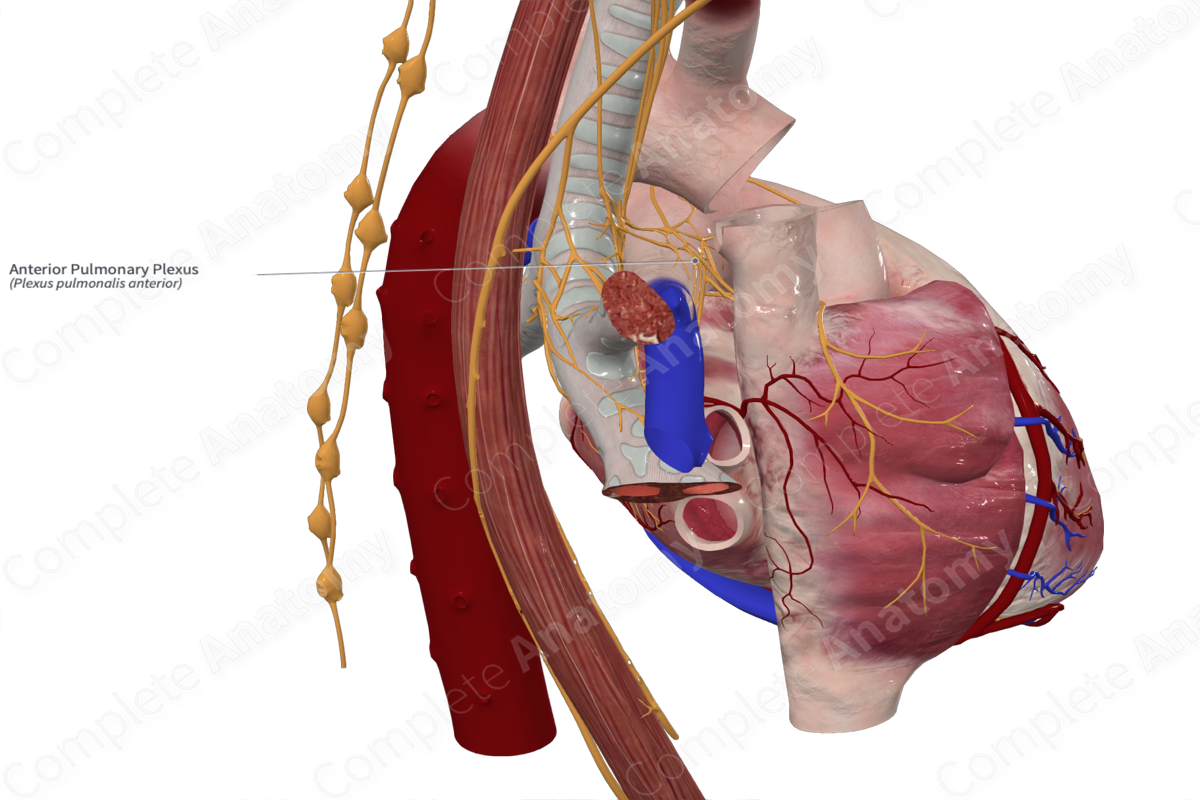
Quick Facts
Origin: Thoracic pulmonary branches of thoracic ganglia and vagus nerve.
Course: Anterior surface of the root of the lung.
Branches: Fibers to the tissues of the lung.
Supply: Sympathetic efferent innervation: contraction of pulmonary and bronchial vasculature, relaxes smooth muscle of airways, and inhibits mucus secretion; Parasympathetic efferent innervation: contraction of bronchial smooth muscle, relaxes pulmonary and bronchial vasculature, and increases secretion of mucus; Visceral afferent innervation: sensory feedback relating to pain, irritants, and stretch.
Related parts of the anatomy
Origin
The anterior pulmonary plexus is that portion of the pulmonary plexus that lies on the anterior surface of the root of the lung. Sympathetic branches come from the thoracic pulmonary branches of thoracic ganglia of the upper thorax. Parasympathetic fibers from the vagus nerve proper, the recurrent laryngeal nerve, or the cardiac plexus combine with the sympathetic efferents and visceral afferents to form the anterior pulmonary plexus. Typically, two or three bronchial branches of the vagus nerve contribute to this plexus.
Course
The anterior pulmonary plexus is that portion of the pulmonary plexus that lies on the anterior surface of the root of the lung.
Branches
The fibers of the anterior pulmonary plexus run along the anterior surface of the primary bronchus and the pulmonary artery towards the lung. As the bronchi and vasculature splits, forming the bronchopulmonary tree, the branches of the anterior pulmonary plexus also split, ensuring innervation of all the tissues of the lung (Kaminsky, 2011).
Supplied Structures & Function
The anterior pulmonary plexus provides both sympathetic and parasympathetic innervation to the lungs and carries visceral afferents back to the CNS.
Sympathetic efferents in the anterior pulmonary plexus are thought to cause contraction of pulmonary and bronchial vasculature, relax smooth muscle of the airways, and inhibit secretion of mucus from the epithelial linings of the lung. Parasympathetic efferents in the anterior pulmonary plexus cause either contraction or relaxation of the smooth muscle of the airways, although it is typically associated with contraction of bronchi. Additional functions include relaxation of pulmonary and bronchial vasculature, as well as increased secretion of mucus from the epithelial lining of the lungs (Chila, 2010).
Visceral afferents travel from the lungs back via both sympathetic nerves to the spinal cord, and the vagal nerves to the brainstem. The functions of spinal afferents are largely unknown but may include pain sensation. The functions of vagal afferents include mediating protective reflexes such as cough and mucus secretion, lung stretch as measured by stretch receptors in the alveoli, and pain sensation (Mazzone and Canning, 2013).
List of Clinical Correlates
—Asthma
—COPD
—Pulmonary hypertension
—Pulmonary embolism
—Neurogenic pulmonary edema
References
Chila, A. G. (2010) Foundations of Osteopathic Medicine. 3rd edn.: Lippincott Williams & Wilkins.
Kaminsky, D. (2011) Netter Collection of Medical Illustrations: Respiratory System E-Book. Netter Green Book Collection: Elsevier Health Sciences.
Learn more about this topic from other Elsevier products



